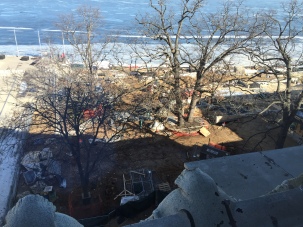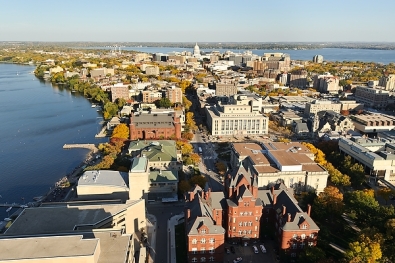UW-Madison Plans for the Future
MADISON, Wis.- Standing on a fifth floor outlook in Memorial Union, Dennis Starrett gazes north to take in the historic terrace and frozen Lake Mendota, a site that University of Wisconsin students and Madison city residents alike have enjoyed since 1928.
However, this view is, and will no longer be, the same. Littered with massive machines, concrete slabs, and busy workmen in yellow hard hats, the Union is undergoing a major overhaul which will permanently alter the landscape.
According to Starrett, a manager for the final phase of the union renovation, these efforts are part of a $42 million project that will increase the union’s capabilities to serve the students, faculty, and residents, while making necessary safety upgrades.

North View of Memorial Terrace Construction from 5th floor. (Personal Picture)
Union planners also seek to maintain the historical aspects of the building and enhance its beauty. “I know there was a lot of conversation and a lot of heartfelt thought put into when should it be done, how should it be done, how do we best serve the student body while we do this and I think they put together a pretty good plan to make that all happen,” Starrett said. The Memorial Union reinvestment project is expected to be complete in 2017.
The renovation of Memorial Union is part of a series of projects underway around the UW campus aimed at maintaining the university’s status as one of the top educational institutions in the country.
According to University Architect and Director of Capital Planning Daniel Okoli, some of the recent boom in campus projects can be attributed to a campus building master plan. The Facilities Planning and Management department created a document in 2005, but later revised it in 2015 to provide greater emphasis on creating open spaces between buildings. Officials note that the full implementation of the plan will lead to the largest campus construction boom since the 1960’s.
Some of the projects in the proposal include the recently completed Dejope Residence Hall and the planned renovation of the Southeast Recreational Facility. Thirty-five percent of the projects in the master plan are completed or near completion, according to the 2015 Master Plan document.
University officials seek to fulfill six specific goals outlined in the master plan: promoting sustainability, building community, fostering student life, creating building and design guidelines, protecting and enhancing existing open spaces, and improving transportation and utilities, according to the 2015 Master Plan website.

The eastern portion of University of Wisconsin-Madison campus. (Photo by Jeff Miller/UW-Madison communications dept.)
Okoli noted that each building reflects one or several goals laid out in the campus design and that each goal demonstrates the values of the university. “It’s important that we pay attention to student life and so you see those projects growing out of the master plan to address student life, like rebuilding the union or RecSports facilities,” Okoli said.
University construction projects, like those at UW-Madison, have not gone without criticism. The 2012 New York Times article “Degrees of Debt” states that recent influxes in university construction spending have led to massive debt accumulation and, consequently, higher fees for students.
During a 2012 NPR segment, Kevin Carey, the director of the Education Policy Program at the New America Foundation said, “But that doesn’t necessarily mean that it’s a good idea to increase spending and pass along many of those costs onto students in the form of higher tuition…And the more the prices go up, the more that these students who are squeezed out of opportunity are middle-income students, low-income students.”
Okoli dismissed claims such as these noting, for UW-Madison, government funding and philanthropy help pay for much of the projects outside of student fees. “Building and renovating buildings on campus are an important part of maintaining an institution so that they remain competitive and attractive for students to come,” the architect said.
Dennis Starrett reinforced this sentiment, noting that, for the Memorial Union renovation in particular, every dollar is spent responsibly and closely tracked. For Starrett, the approach towards responsible and innovation construction like Memorial Union represents UW’s institutional role and mission. The project manager stated,“Wisconsin has always prided itself in being a leader in education and the whole educational process, and I think the Union is certainly a huge part of that.”
Note: Sources listed in text hyperlinks. Interview with Starrett conducted on February 20, 2016. Interview with Okoli conducted on March 9, 2016.